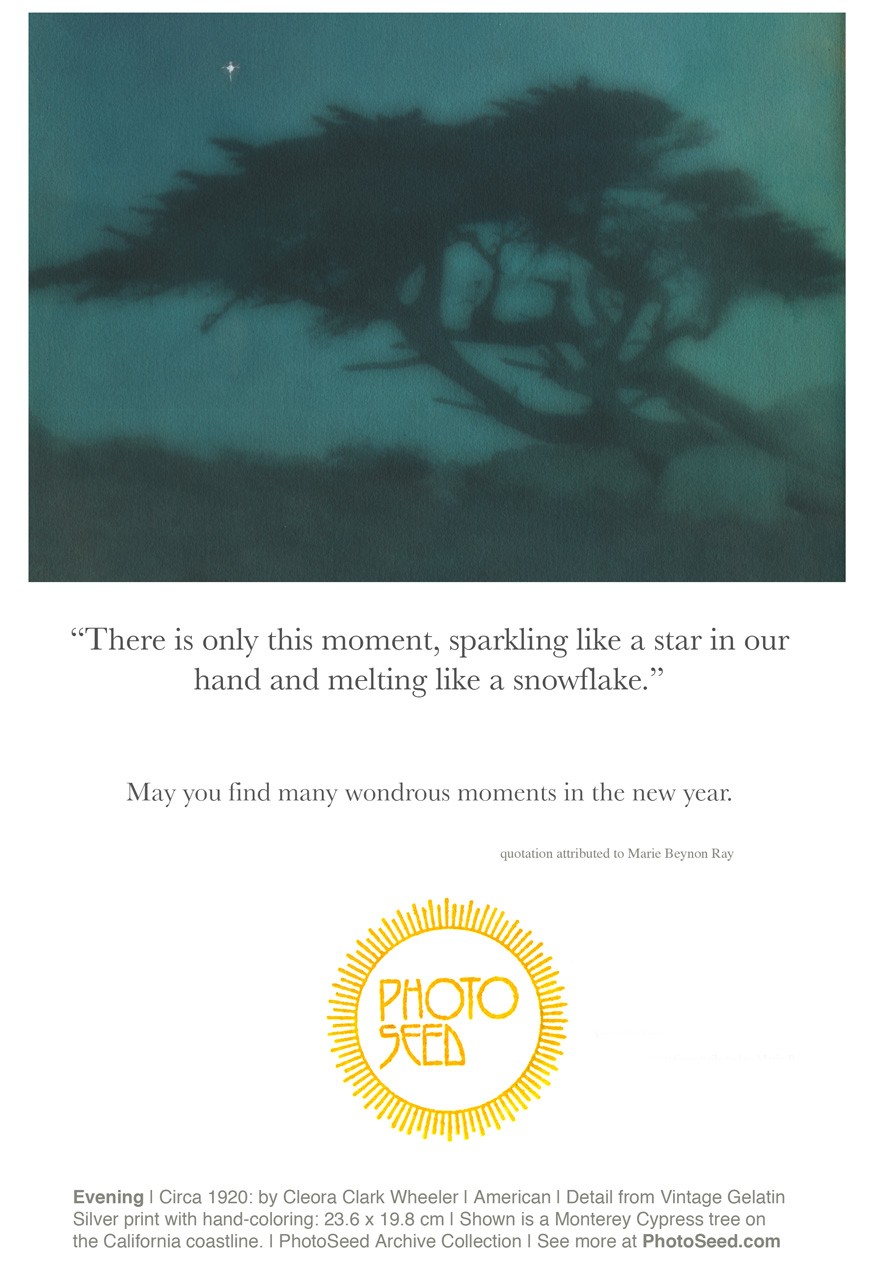
Yesterday officially marked one year since I launched PhotoSeed.com as a public site and I wanted to thank everyone who has taken the time to visit or who has inadvertently stumbled upon us. To date, this site has had tremendous world-wide reach in its short life, with hundreds of thousands of page views perused by visitors hailing from a total of 163 countries & territories. In addition, PhotoSeed received a Webby, the highest industry award for a website in the Art category during a ceremony in New York City this past May. And who knew we could count a very loyal following from those residing in Vietnam’s Ho Chi Minh City? I’m not a micro-focused person by any means, but the wonders of Google Analytics never cease to amaze.
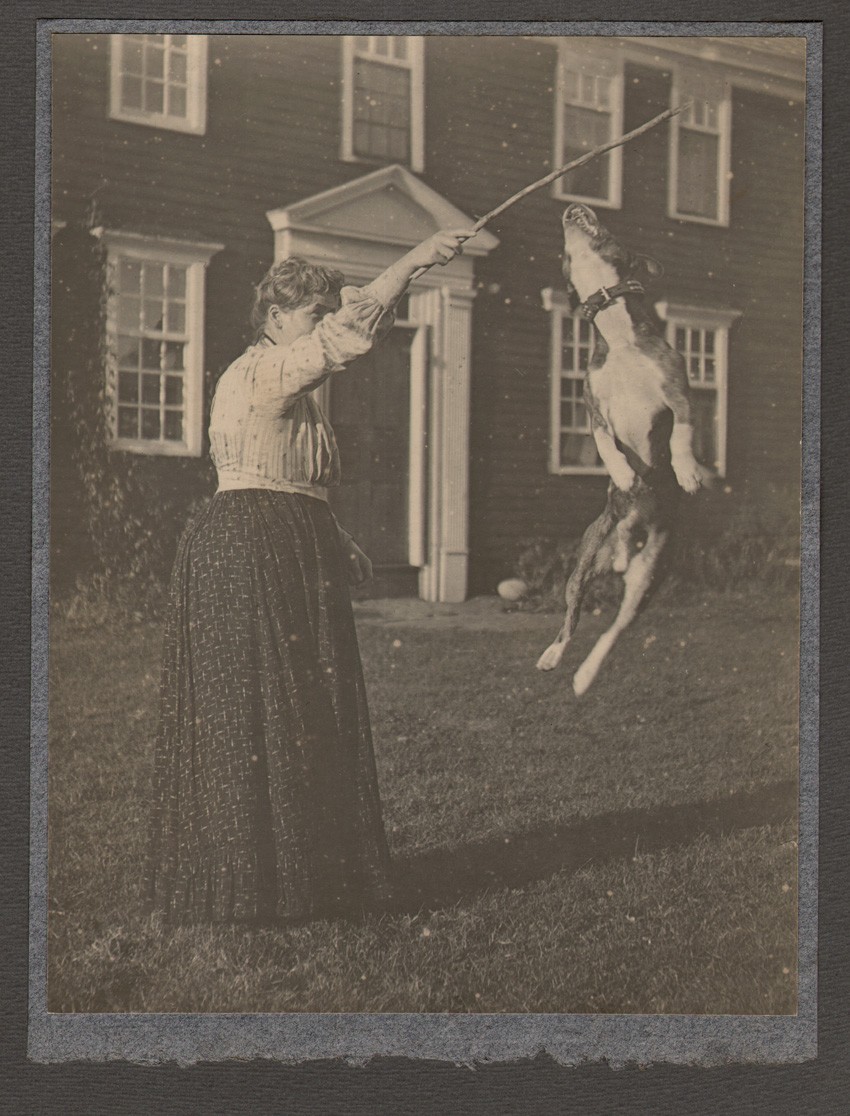
C.M. Whitney, (Chester Moulton) American, b. 1873: “Peter” or “A High Jumper”: 1907: vintage gelatin-silver photograph: image: 19.1 x 14.7 cm | primary support: 20.4 x 15.4 cm | secondary support: 30.5 x 25.4 cm : from: PhotoSeed Archive
My plans and goals for the next year are many. Ultimately, I would like to devote my time to the site full-time, with the means of supporting this dream through a combination of an online sales gallery selling vintage material, licensing agreements, and, perhaps, select archival reproductions for purchase. As always, your suggestions are welcome as I approach this fork in the road, and I sincerely welcome your input and ideas going forward. As my own time allows, it is my intent to continue building on my own evolving scholarship as I assess and then post material from the vintage work making up the PhotoSeed Archive. As I’ve said before, there is every reason to “get it right” the first time, and I don’t see it as a race.
And so it is my honor, delight, and satisfaction to be able to shine light and—hold for this metaphor—let the creative flowers from my photographic brothers and sisters bloom after hiding in the dark far too long. I hope you enjoy the discoveries and continue the journey with us.
-David Spencer
I wanted to give it a little time before commenting here on my recent trip to New York City to attend The Year Distilled-otherwise known as the Annual Webby Awards. PhotoSeed had previously been named the Webby winner in the Art category on May 1st of the year, thanks to the efforts of Jay David and Tyler Craft (formerly) of the TOKY agency of St. Louis; who, unbeknownst to this blissfully ignorant site owner, had entered it for consideration in the 16th annual installment of the award.
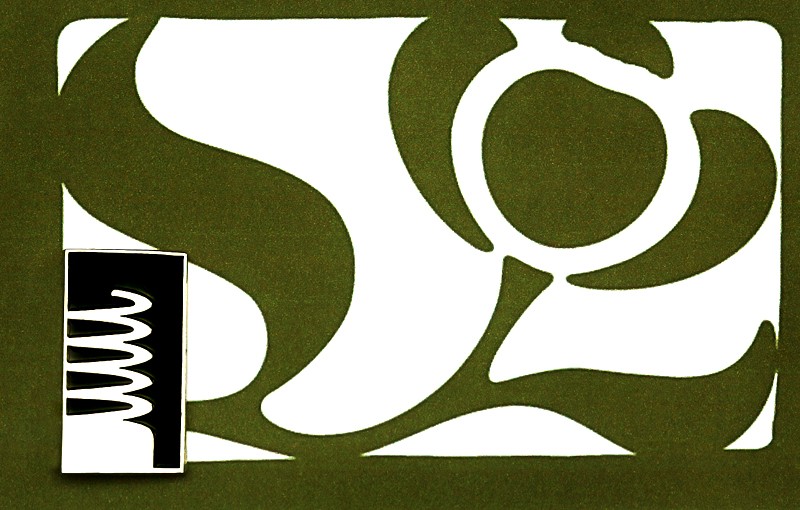
“You’re a winner” I was told upon my arrival to the front lobby of the Hammerstein Ballroom. And with that, I was presented with this smartly designed Webby lapel pin, seen here against the gorgeous emerging olive drab flower designed by TOKY Interactive Creative Director Jay David for PhotoSeed.
Of course, “giving it a little time” puts me at a seeming disadvantage when it comes to our lovable information superhighway. Speed is the thing they say: something I’m uncomfortable with when it comes to dealing with nuance in the form of the photographic heritage that will continue to evolve from here.
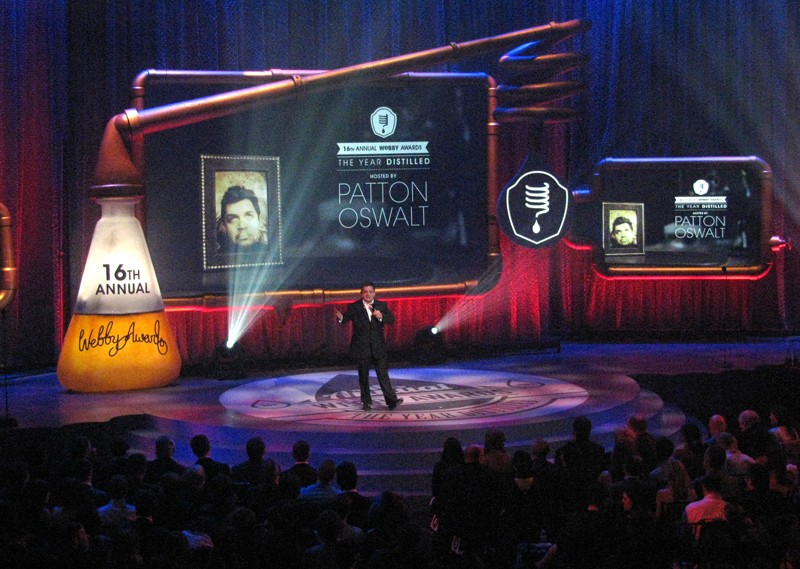
Stand-up comedian and actor Patton Oswalt opens the 16th Annual Webby Awards onstage at the Hammerstein Ballroom in New York City on the evening of May 21, 2012. The PhotoSeed website won this year’s Webby award in the Art category. Photo by Shannon O’Brien
Even as a nominee for the award, an online editor in Spain asked if I had a press kit–an idea foreign to my way of thinking, but perhaps an essential component for those wanting a more concise definition of who and what we are. And so, from gray to black and white: the following a quote from the release later cobbled together courtesy of my wife, the friendly interrogator:
What’s your motivation?
I’ve always loved art in all its many forms, which is the foundation for the entire site. Photography was always one of those arts. I was lucky as a child to be exposed to all types of art—museums, music, drama, dance. In my teens, I became interested in photography. As a lover of art, I see beauty in the world. One of the most important elements of this site is for people to leave it with a renewed sense of the beauty that’s in our world. In some respects, the site is a keyhole to the past that doesn’t exist any longer on many levels.
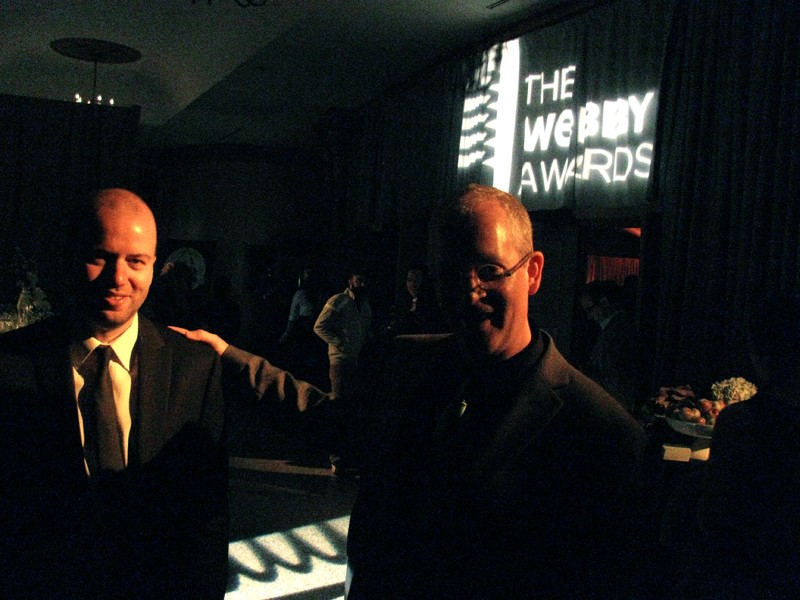
PhotoSeed site owner and curator David Spencer, right, hangs with Jay David during the pre-party at the 16th Annual Webby Awards at the Hammerstein Ballroom in New York City. Jay and Tyler Craft, formerly Lead Developer at the TOKY Branding + Design agency in St. Louis, are responsible for designing and building the PhotoSeed website. Photo by Shannon O’Brien
The trip to New York was icing on the cake: a celebrity and bling-fueled feeding frenzy for those connected or in the know for all-things internet. Like the majority of winners, however, PhotoSeed didn’t enter the live-streaming conversation hosted by comic and actor Patton Oswalt, but took on the form of hand shakes and raised glasses among friends, just what I expected and cherish the most. I would not have missed it. My wife’s observation before the show that several Hollywood movie stars were in attendance several feet from our conversation seemed most unconvincing to me, until TOKY owner Eric Thoelke mentioned one–Juliette Lewis (a Webby winner)–had played opposite Robert De Niro in the 1991 remake of Cape Fear. The other, an actress wearing a simple dress, only confirmed by me several days later when I saw her official red carpet photo, struck me as a “normal” looking person, and reminded me of those photographs I’ve seen of HM Queen Elizabeth II wearing a raincoat while blending in with the crowd.
Oswalt’s tongue-in-cheek opening monologue was spot on: especially the following observations:
This is the night when the best and brightest on the internet meet face to face…look at each other…and all say…you are not what I expected either…at all. But the Webbys have brought us all together tonight to celebrate the thing that keeps us all apart. As well as also we are going to be celebrating the 5% of the internet that is not porn. So..really…that’s… kind of important. That’s right.
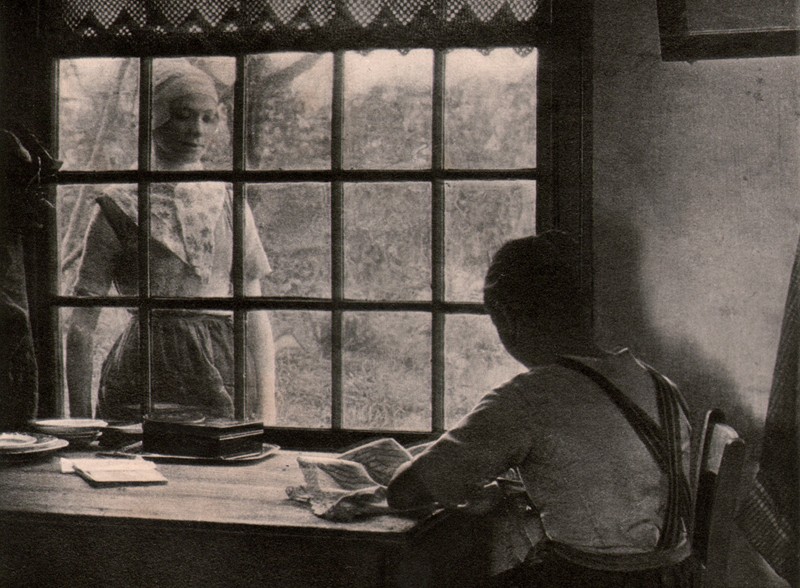
Detail: “Veluwe Interior from artist Jan L. Kleintjes’s atelier in Heerde”: by Dr. L. Kleintjes: from: Photographische Rundschau 1903 (17.0 x 14.6 cm: December: Heft 23 Plate 59): This genre photograph from the PhotoSeed archive strikes me as being symbolic of what often passes for human “interaction” in the hyper, digitally-connected present day of the year 2012.
His middle thought bubble about the web keeping us apart seems especially acute today, and perhaps reason for alarm in terms of keeping humankind’s social construct going forward.
My eagerness to connect at the show resulted in one slightly ill-informed blog post several days after the fact, with the writer’s assessment of PhotoSeed being no more than a “fancy Flickr account for old-assed photos.” A good lesson in humility for me. It further reminded me critics will always exist, and looking back over 100 years, proof that history repeats. Even Alfred Stieglitz reprinted mocking reviews from the New York press in his journal Camera Work after his gallery, 291, mounted shows of art and photography that radically stirred the pot of public discourse. Ego aside, the journalist in me liked the ideas in this blogger’s writing anyway. Thank goodness someone is still willing to go out on a limb and call it as they see fit.
As for the show itself, which began outside the Manhattan Center on a drizzly, early New York City evening, the literal stars in Lou Reed’s lyrical song to Andy Warhol could be seen on the red-carpet and later in the house. Well before comic Louis CK wrapped it up several hours later by giving his five word Webby speech (“When I die, bye bye”), Apple’s founding icon, Steve Jobs, was memorialized by U.S. Presidents, Bono, and introduced by actor and activist Richard Dreyfuss. A man whose feisty demeanor has apparently continued unabated since his role in the 1977 film “Close Encounters of the Third Kind,” which finds him rearranging his living room into a mock-up of a Martian landing space.
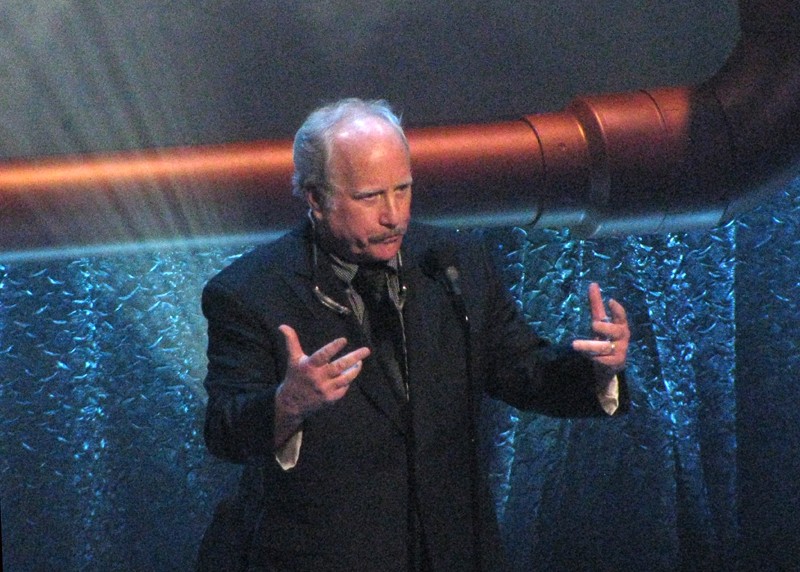
Before honoring the passing of Apple’s Steve Jobs onstage during the Webby awards, actor and activist Richard Dreyfuss first launched into the business practices of Facebook and Google: “If you’re going to take our privacy away from us, then why don’t you tell us something private about yourselves? And if your gonna change our world, why don’t you pay for it, because it’s theft” he said. Photo by Shannon O’Brien
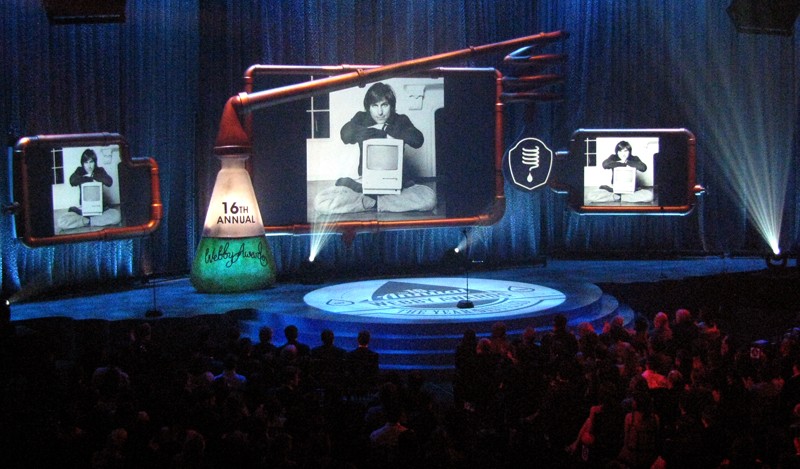
Steve Jobs, 1955-2011: co-founder, chairman, and chief executive officer of Apple Inc. was honored in a video tribute during the 16th annual Webby awards at the Hammerstein Ballroom in New York City. Photo by Shannon O’Brien
But the biggest star on this night? Photography itself. Those nicely dressed folks dishing out snappy five-word acceptance speeches on the Hammerstein Ballroom stage surely owed it big time, and so do I. Webby Breakout of the year Instagram, a social media app that, according to the breathless prose of the official awards booklet, was, among other things, responsible for “furthering the democratization of photography on the Web” was preceded by a lip-synced video spoofing so called “food porn” photography.
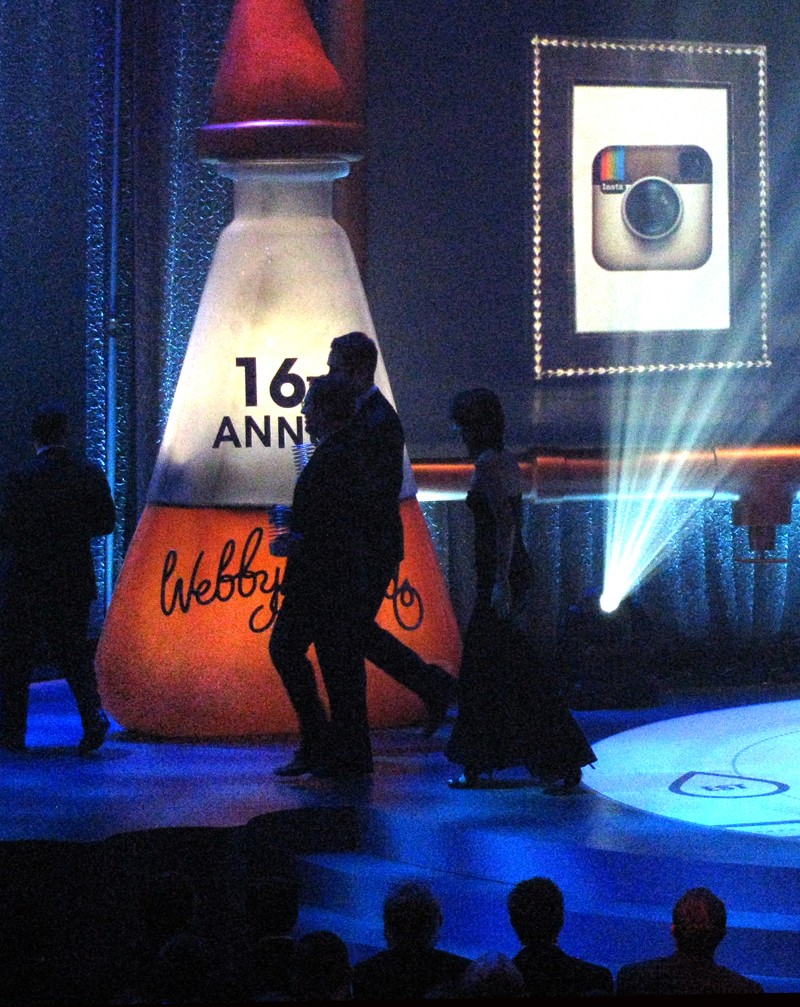
Exit, stage left. Instagram co-founders Kevin Systrom and Mike Krieger head backstage after Systrom accepted the Webby for Breakout of the year after saying “This here requires no filter”. Photo by Shannon O’Brien

But could this be? They say Abraham Lincoln invented Facebook, so why not PhotoSeed inventing Instagram? After all, the buzzword I heard at the Webby awards was all about romance in conjunction with this revolutionary filtering device that spits out photographs in a square shape via your smart phone. Not so hard really when transforming this detail of the vintage pictorialist image “Late Bloomers” (Herbstzeitlosen) by Swiss photographer Frederick Boissonnas found in the PhotoSeed archive. from: Photographische Mitteilungen 1902: November: 19.9 x 8.4 cm
“Eat It Don’t Tweet It” by American Hipster + Key of Awesome makes fun of smart phone photographers who insist on photographing everything they eat and posting it to social outlets. Sung by three band members, one being an ordinary looking bloke as well as two keyboard players dressed as a cupcake and the other sporting a lobster suit, lyrics include more photographic references: “you are pathetic we’re not photogenic” and the real compliment if you are a photographer famous enough: “a gastronomic Annie Leibovitz.” The last two photographic highlights for the night I’ll mention are 1. inspiring and 2. weird.

Live…onstage at the Webby Awards! “You are pathetic we’re not photogenic” and other gems make up the lyrics to the music video “Eat It Don’t Tweet It” by American Hipster + Key of Awesome. Photo by Shannon O’Brien
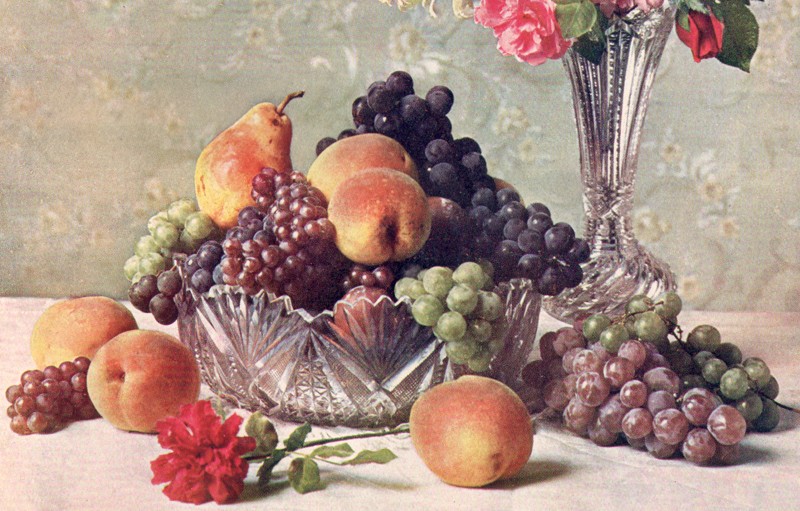
Speaking of early examples of food photography: arrangements such as this vintage view of artfully arranged fruit and flowers were always typically presented as a showcase for the latest and greatest technology from the early years of color engraving, this being an example of a multiple color halftone believed to be printed in three colors by the Photo-Chromotype Engraving Company of Philadelphia. (detail: PhotoSeed archive: “Fruit and Flowers from Nature” from: The Photographic Times 1898, January: 19.2 x 16.1 cm )
In the inspiring category was the image of Holocaust survivor Tibor Sands, who stood on stage and accepted two Webby awards on behalf of the Remember Me? project done by The United States Holocaust Memorial Museum-voted best cultural institution on the web. But what sealed it was a simple portrait photograph projected behind him. Most in the crowd, myself included, may have mistaken it for a Nazi evidentiary photograph at first glance. But with a few keystrokes searching the Web, a happier background for it emerged, showing again photography’s importance as the ultimate documentarian. It turned out to be a passport photograph of a very young Tibor Munkácsi- taken in Germany’s Kloster Indersdorf near Dachau right after World War II by an American GI. As of this writing, 330 Holocaust survivors have been identified by means of anonymous photographs like this one because of the Remember Me? project. Munkácsi, it turned out, was heading for a new life in England and eventually to the United States, where he changed his last name to Sands and became a cinematographer in Los Angeles. No wonder he can be seen with a slight smile on his face in the picture.
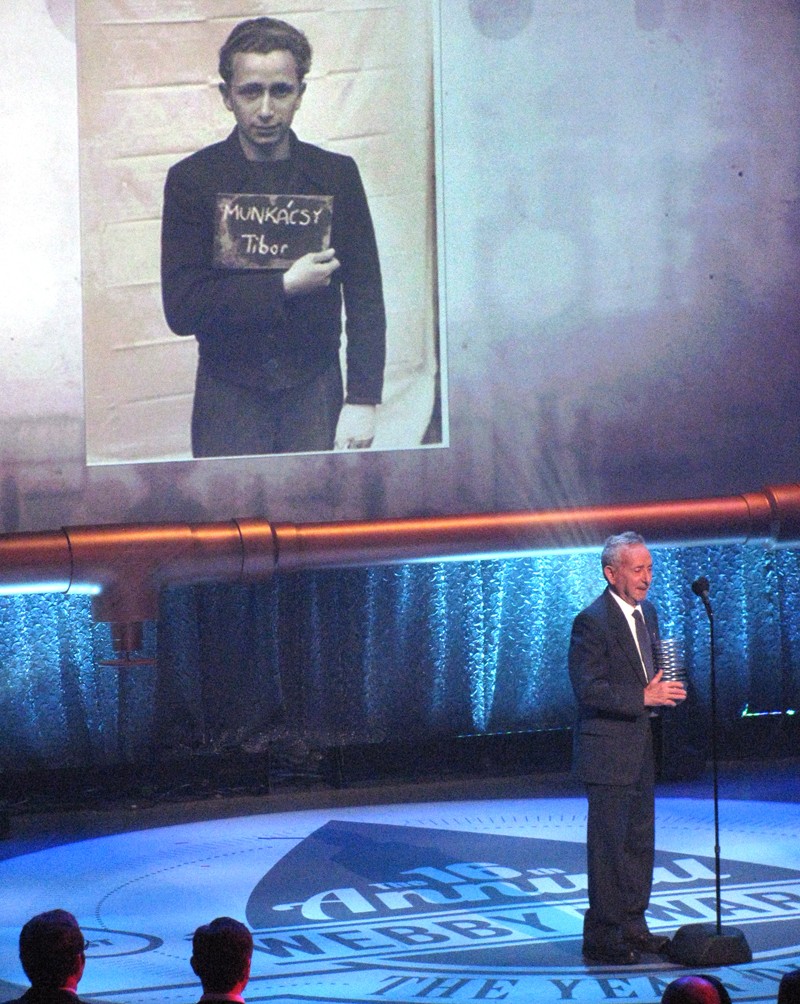
Then and now. Holocaust survivor Tibor Sands accepted two Webby awards on behalf of the Remember Me? project done by The United States Holocaust Memorial Museum in Washington, D.C.-voted best cultural institution on the web. Photo by Shannon O’Brien
Finally, a dictator gets his due, sort of, and a great example of how photography can cut two ways. When he was alive, the official ministry of North Korean public relations-if there is such a place- periodically issued “official” photographs of their “dear leader”, better known as Kim Jong-il.
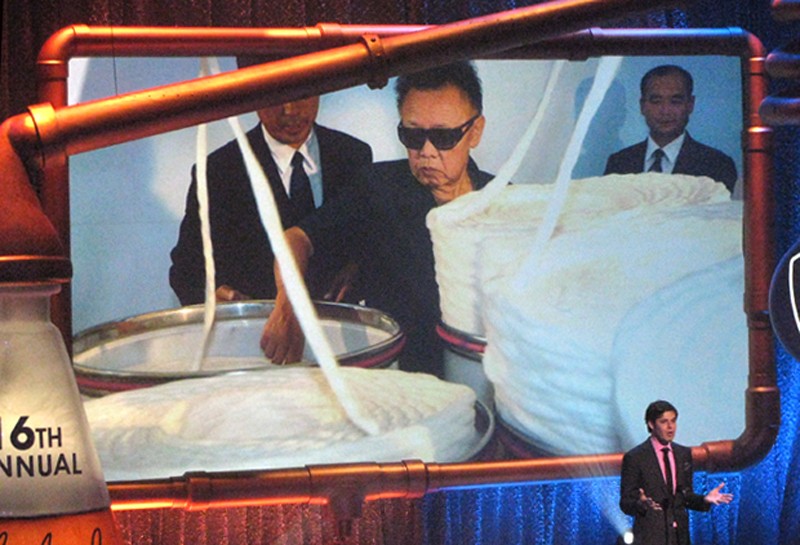
Weird Webby: or how “public relations” can be taken to extremes, with hilarious results. One of the many photos of “dear leader” Kim Jong-il inspecting “stuff”, from the Tumblr blog “Kim Jong-il Looking at Things.” Several were projected during the show, including a real beauty of the dear leader checking out some large fish. Or was it Kim Jong-il in disguise? Photo by David Spencer
Enter Lisbon-based João Rocha to re-appropriate history in a most cunning and amusing way. What to do with this plethora of propaganda relating to photographs of Kim Jong-il in the blogosphere? Why, a dictator in a stiff suit, shades and void of all expression makes for the perfect aggregation target and voila, a new star of sorts in the form of a Tumblr blog called Kim Jong-il Looking at Things. Live on the Web since 2010, the site was awarded a Webby People’s Voice award, inducing no further comment other than the following observations from Rocha, who succinctly states his motivation thusly:
“the dear leader liked to look at things.”
“why is it so funny? i have no idea either”.
Since PhotoSeed launched a month ago, I have been putting together material on a run of the important German photographic journal known as Photographische Mitteilungen. (Photographic Reports) Several hundred photographs, almost all of them hand-pulled photogravures, are now searchable in our archive database. As a working photographer myself, it is an honor to be able to give new light to this material and introduce fresh eyes to it over a century later.
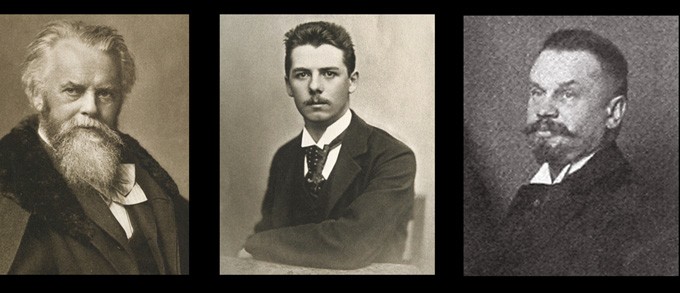
From left to right: Photographische Mitteilungen founder and editor H.W. Vogel: 1864-1898; his son Dr. Ernst Vogel, who edited the journal from at least 1893-1901; and Paul Hanneke-sole editor from 1901-1911.
The challenge for me has been trying to get things right the first time. The language barrier in assessing this material has often been difficult in some cases to overcome. But fear not. If I’m not comfortable about something regarding a translation, I will probably not include it unless I spell it out verbatim on the site-which I have done in a few cases already. I wish I could say I spoke five languages but since four years of high school French is my reality, Google as well as other online translation software has taken up the slack in this department. I have been translating titles of the work where appropriate (found in the misc. tags area) in order to give our English-speaking audience an idea what the photographer’s intent was as well. “Unidentified” seems to be my new favorite word on some days but consistency will always be my mantra while adding material to the site.
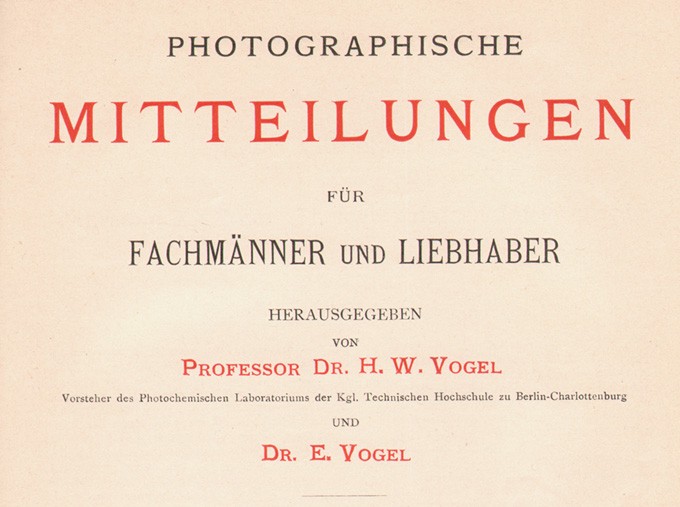
This detail shows the title page for the 30th year of Photographische Mitteilungen covering 1893-1894.
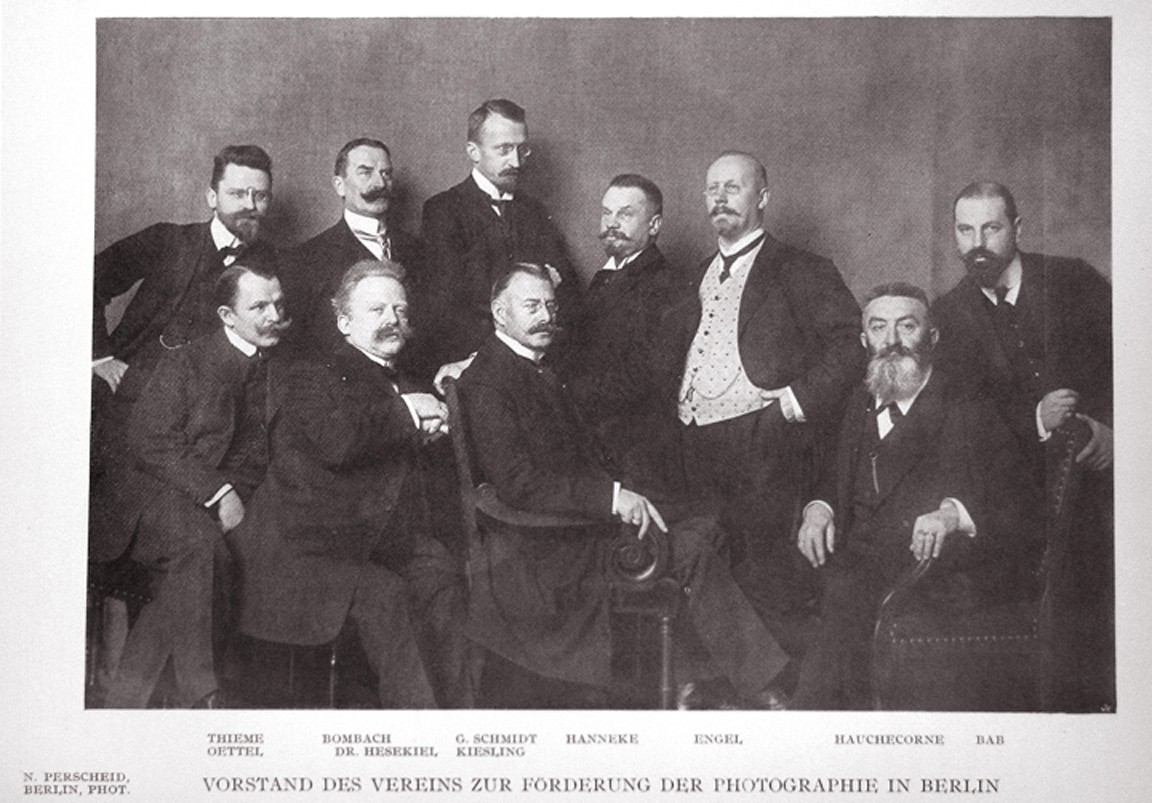
This photograph taken by Berlin photographer Nicola Percheid from the March, 1909 issue of Photographische Mitteilungen shows board members of the Association for the Promotion of Photography in Berlin. (Vorstand des Vereins zur Förderung der Photographie in Berlin) This is the same organization founded by H.W. Vogel in 1863. In the early years of the publication, the name was incorporated into the title page since the journal was actually its mouthpiece. (example- Photographische Mittheilungen: Zeitschrift des Vereins zur Förderung der Photographie) Over the years, the journal lost the “h” in Mittheilungen as well. Seen in this photograph at center is journal editor Paul Hanneke and to his right, journal publisher Gustav Schmidt.
In researching the history of the journal, I discovered early examples of color plates reproduced from 1893. Twenty years earlier, journal founder and photochemist H.W. Vogel had first figured out how color sensitizing agents could be added to photographic plates in order for objects to delineate themselves into their proper shades of gray.
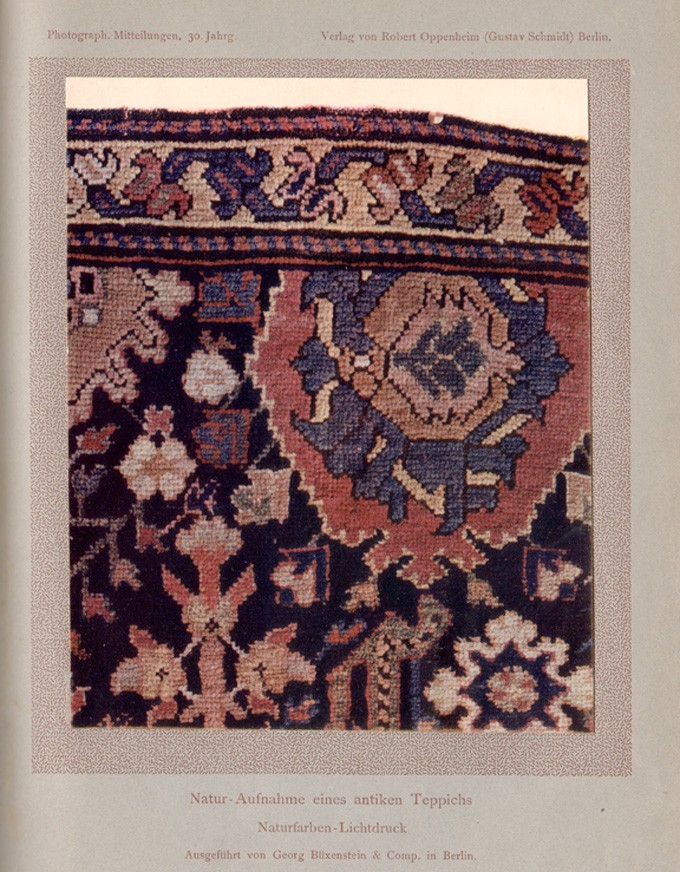
This very early natural-color collotype photograph showing a swatch of an antique rug was done by the atelier Georg Büxenstein in Berlin and reproduced as a full-page plate in the April 15 (heft 2) 1893 issue of Photographische Mitteilungen. Dimensions- image- 15.3 x 12.2 cm -support- 24.4 x 16.9 cm (trimmed)
Later, his son Ernst Vogel- (who had joined his father as co-editor at an undetermined date but at least since 1893) took up the challenge of printing three-color photographs in halftone as well as collotype. He first teamed up with William Kurtz in New York in 1892 (who was a good friend of his father’s) and a year later with Berlin engraver Georg Büxenstein.
The three-color halftone below showing a still life of fruit reproduced in the January, 1893 issue of the journal is believed to be one of the very first three-color halftones ever done on a large scale. In Berlin, Ernst Vogel’s subsequent business relationship with Büxenstein bore additional fruit in the form of this firm’s exquisite gravure plates now available for your examination on our site.
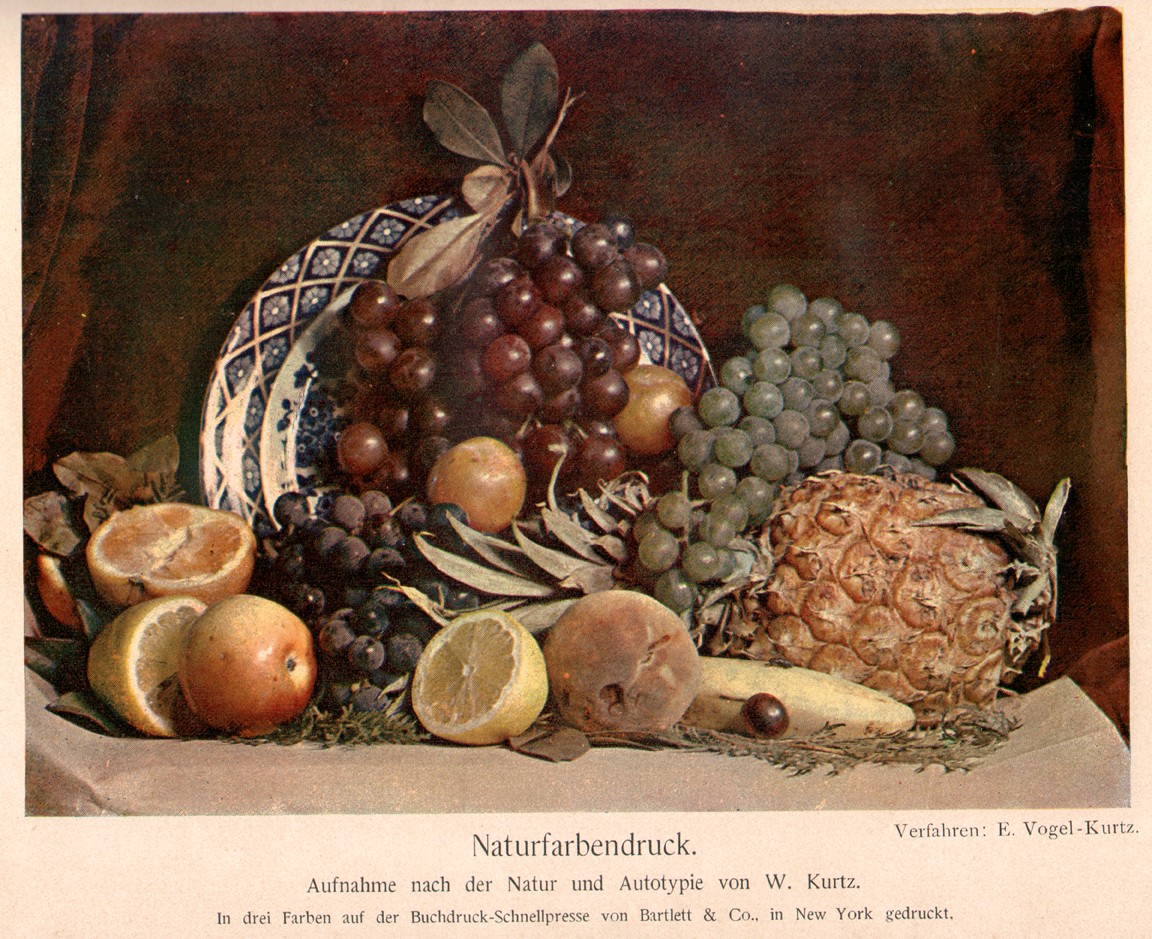
The New York engravers Bartlett & Co. under the direction of William Kurtz and Ernst Vogel printed this very early three-color halftone image. Dimensions: image: 13.3 x 18.3 cm : support: 16.7 x 24.5 cm coated stock paper (trimmed)
I tend to get obsessed with detail oriented things and the lead-up to our official PhotoSeed launch party on Saturday, July 16th, 2011 was no exception. First off were the invitations. With my goal of making each invite a kind of keepsake for recipients attending or not attending the party, I first tried running thick-stock watercolor paper through an ink-jet printer and got results which were not consistent, with roller lines from the printer making more of an impression than Jay David’s outstanding PhotoSeed logo and custom typography did, and with the printer rejecting the thick paper stock on the second run through.

Just wanted to spead them all out one last time before entrusting their journey to Uncle Sam.
Plan B entailed going to a well-known and fully capable print shop in our fair city. They were gracious and ran a comp on a high-end color laser copier but the color wasn’t even close, with the ink resembling an elastic skin on the paper surface.
With my mind made up that the look of the invitations had to resemble a fine print, I revisited the idea of watercolor paper as Plan C, which involved part of a Saturday in St. Louis yakking to a very patient salesperson at a large art-supply store. I settled on some large sheets of French Arches watercolor-very thin- that would not pose a problem with the inkjet printer. I commenced in trimming them down to size in the store and later feeding them one by one into the printer, twice, in order to print the verso party particulars. Success at last. My wife Shannon came up with the groovy idea of incorporating a Haiku into the invite as well:
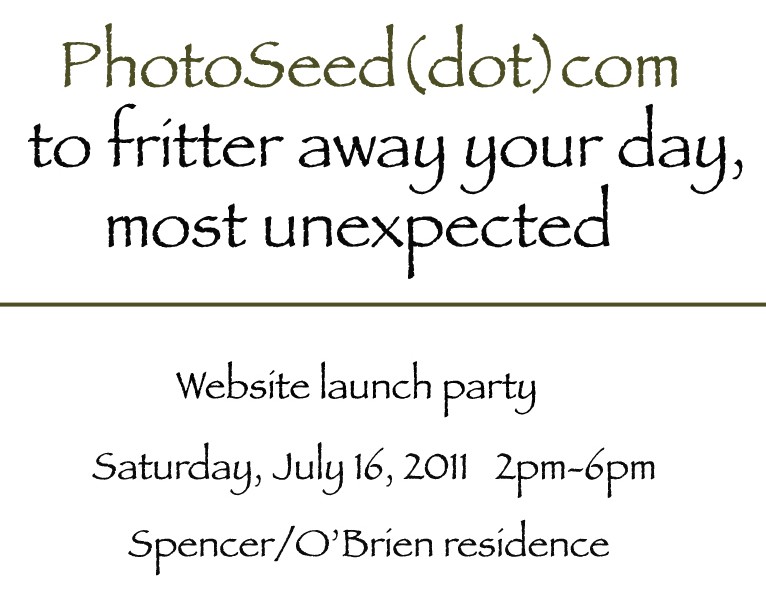
Fritter away!
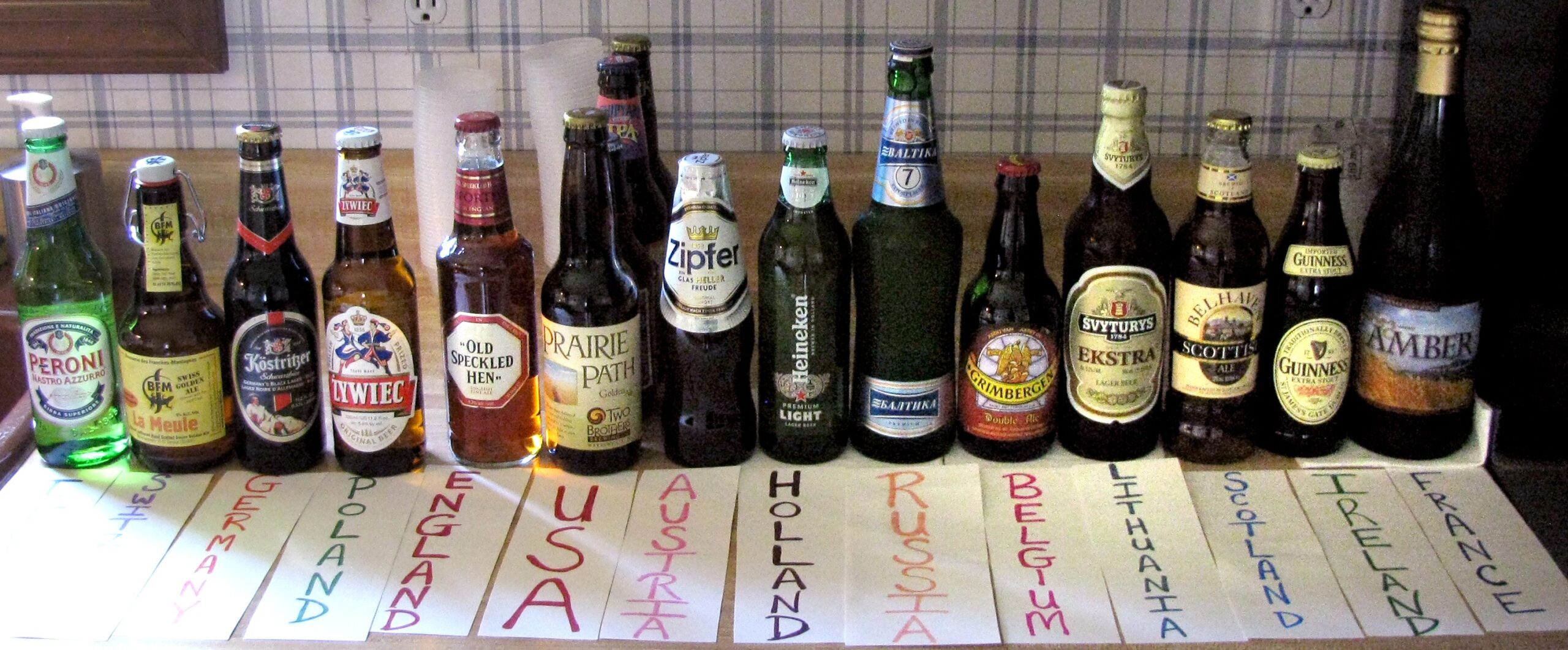
Still have not opened Russia and a few other countries, but I’m looking forward to it.
On launch day, beer, procured from 14 of the 17 countries currently represented in the PhotoSeed archive, was on hand for party tasting. An unexpected gesture from site developer Tyler Craft, who could not attend, seemed appropriate. A bottle of wine which he had ordered on the internet arrived in the morning and I used it later to raise a glass with thanks to everyone who has made PhotoSeed a reality. Thank You!
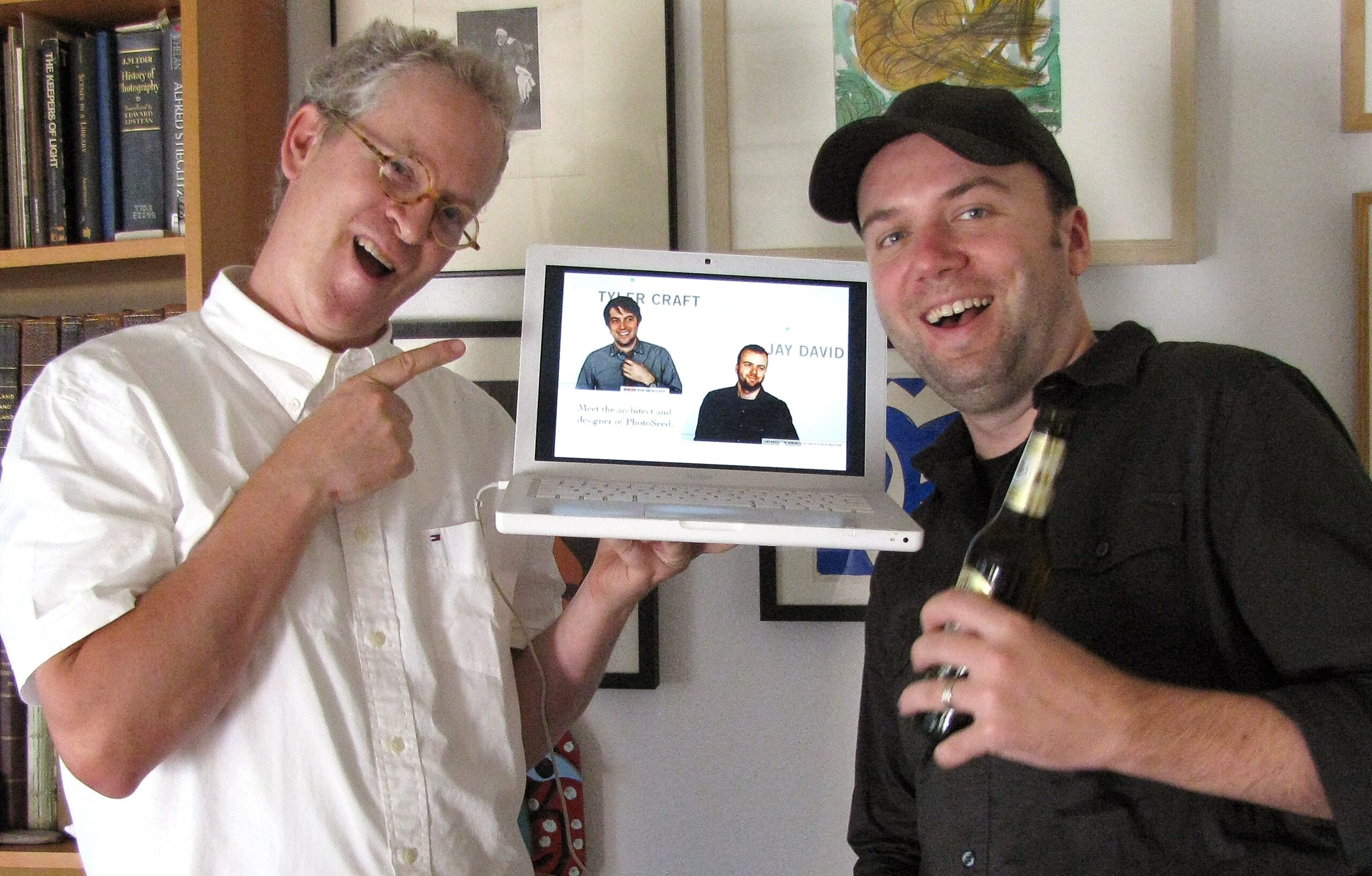
In the aftermath to the virtual ribbon cutting, Spence, left, and PhotoSeed designer Jay David pay homage to a cyber-shrine of site developer Tyler Craft, (and himself-thank you very much) during the party.
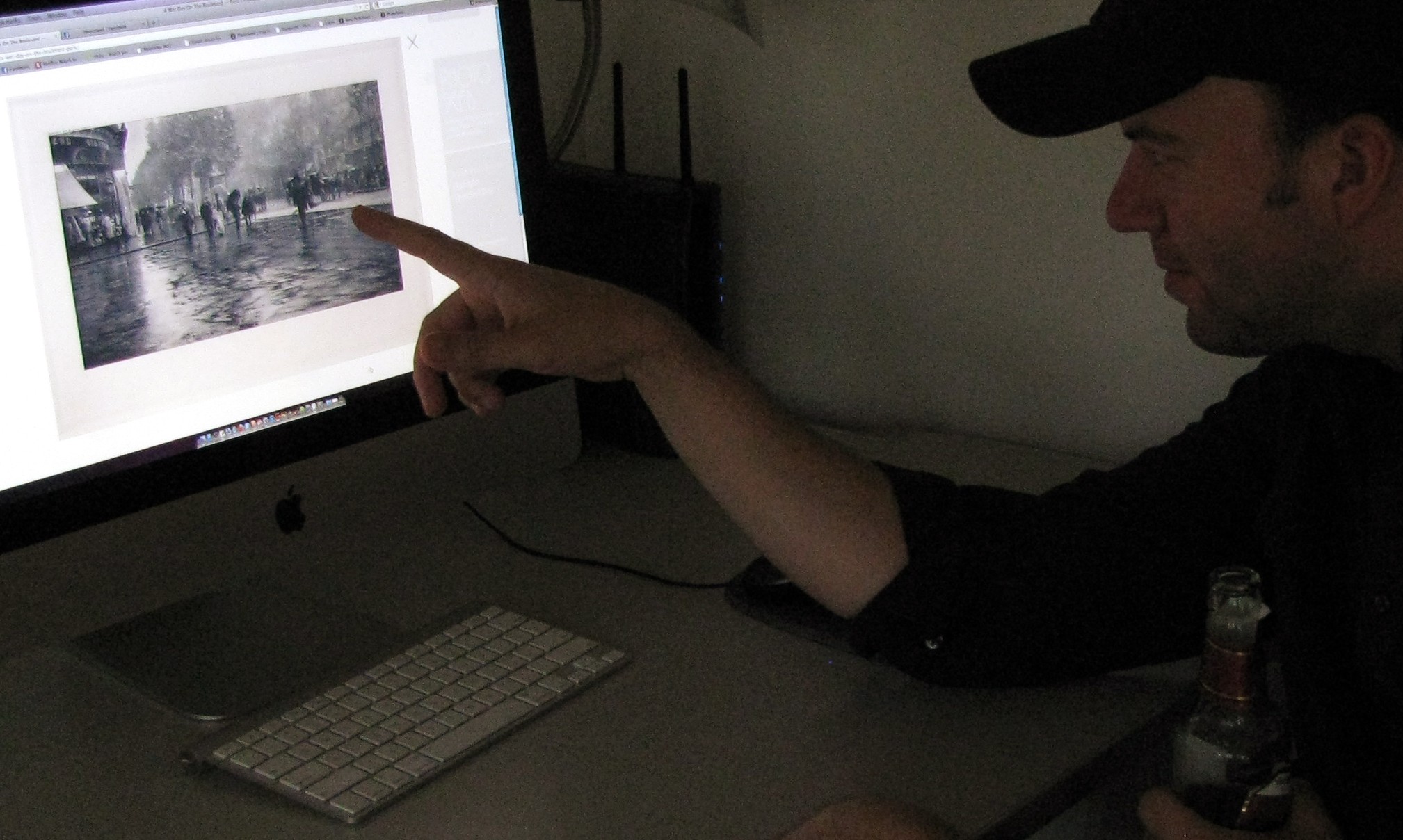
Jay checks out one of the large plate Stieglitz gravures on the site (Wet Day on the Boulevard-Paris, 1894) using the lightbox mode.